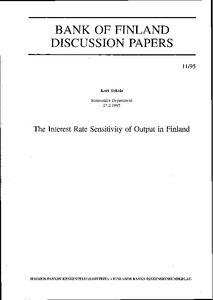The interest rate sensitivity of output in Finland
Takala, Kari (27.02.1995)
Numero
11/1995Julkaisija
Suomen Pankki
1995
Julkaisun pysyvä osoite on
https://urn.fi/URN:NBN:fi:bof-20140807391Tiivistelmä
Monetary policy affects the economy through the exchange rate and interest rates.It is assumed that the relationship between interest rates and GDP is negative and that interest rates affect GDP more powerfully than the other way around.These conclusions are confirmed here.Estimated elasticities--which compare annual percentage changes in GDP to annual percentage changes in the interest rate-produce interest rate elasticity close to unity.It should also be stressed that a nominal interest rate effect is found instead of a real rate effect both in GDP and its components. For private consumption, the interest rate measures the relative future price of consumption, which includes substitution and income effects.According to estimations the interest rate elasticity for non-durable consumption is around -0.4, which indicates the dominance of the substitution effect. For durable purchases, the interest rate elasticity is much higher and is also volatile.Rough estimate showed that the interest rate elasticity for durables could be around -4.0. For private investment, the interest rate measures the opportunity cost of investment and a cost factor in debt financing.Financial deregulation has obscured the importance of interest rates in determining manufacturing investment.It seems that during the boom years domestic lending rates lost their significance in affecting investment plans.A rough estimate for a long-term interest rate elasticity of manufacturing investment could be -2.On the other hand financial deregulation has clearly increased the power of interest rates in determining the level of housing investment. During 1980s the real lending rate became a significant determinant of housing investment, and we cannot reject the hypothesis of unitary elasticity, ie. elasticity of -1.
